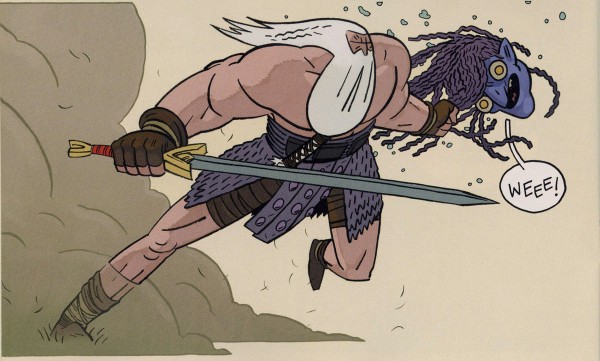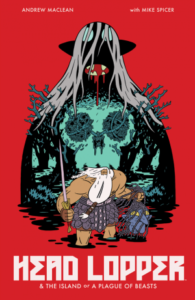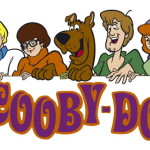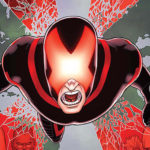
Head Lopper Volume 1
Written, Drawn, and Lettered by Andrew Maclean
Coloured by Mike Spencer
Review by Billy Seguire
 Andrew Maclean’s Head Lopper proves a story steeped in violence doesn’t have to be dark and brooding. Filled with imaginative design, engrossing characters, and a wealth of gorgeous landscapes, I feel the same way reading Head Lopper as I do playing a well-planned Dungeons and Dragons campaign. With a story heavily influenced by the strong, stoic figures of Norse and Greek mythology, Maclean’s characters feel real and layered even in their simplest forms. It’s a living world that connects all the right pieces to provide a truly entertaining tale, and it’s awesome.
Andrew Maclean’s Head Lopper proves a story steeped in violence doesn’t have to be dark and brooding. Filled with imaginative design, engrossing characters, and a wealth of gorgeous landscapes, I feel the same way reading Head Lopper as I do playing a well-planned Dungeons and Dragons campaign. With a story heavily influenced by the strong, stoic figures of Norse and Greek mythology, Maclean’s characters feel real and layered even in their simplest forms. It’s a living world that connects all the right pieces to provide a truly entertaining tale, and it’s awesome.
The world of Head Lopper definitely qualifies as high fantasy in the old-school vein. Blood is spilled freely and without consequence as our protagonist hacks and slashes his way through the varied landscape of Barra and fights imaginative creatures that make its world feel truly alive. Although there are many homages to figures like Hercules and Odin, there’s very little reliance on old standbys here. Often the best monsters or character designs in Maclean’s story come from original ideas, riffing on fantasy tropes while creating something genuinely new and interesting at the same time. Every time you think you understand the world, some new element is added in, including two unfathomable monsters fought before the book is finished. Their design and function are endlessly creative and all feel part of the same landscape.
The way world-building unfolds in Head Lopper is tremendously powerful. The entire story takes place on the Isle of Barra, a kingdom enduring a decades-long plague of beasts. Norgal arrives by ship, first seen cleaving the head off a Sea Serpent, but is soon tasked by the Queen herself to slay the Sorcerer of the Swamp. This quest leads him through the heart of Barra, exploring the strange varied topology of this locale and the history of Barra’s political landscape. You can tell Maclean has taken his time crafting this world. His triple duty as writer, artist, and letterer (along with colouring chapter three) speaks to his dedication to this story. All it takes is one look at the map of Barra that opens every chapter to understands. It has the feel of a Lord of the Rings comic that was allowed to mix and match its mythology with all the best bits of Adventure Time and Dungeons and Dragons.
Norgal is an extremely engrossing protagonist. Also known as Son of the Minotaur, the Executioner, and Head Lopper, Norgal is a hulk of a man with a flowing white beard and a voice that sounds “like stone scraping against bone”. It’s a design that emphasizes strength and power. He’s a man who’s prone to violent outbursts, but never on the unwarranted. He enjoys throwing his head back in a hearty laugh and the company of old friends. He simply has no interest in the world outside of battle. The world’s biggest sword fan, Norgal takes every opportunity to solve problems with his sword and tell others it’s the solution to their problems as well. A neutral good character, Norgal is a man who brings honour to the title of Head Lopper, while at the same time shunning the use of a title to describe him at all.
In stark contrast to those values, Agatha Blue Witch is a sharp-tongued severed head of a witch that Norgal keeps draped across his shoulder. Cursed with life after death, she spends most of her time in the book annoying Norgal and trying to get a taste of tasty meat. With freedom in the book to say anything she pleases, Agatha has the instant charm and wit of a crone in a Studio Ghibli film. She is a pest and a burden at all costs. By the same rights, she’s also the perfect companion for stoic Norgal and acts as a tension breaker and comedy relief in several important scenes. There is a scene where Agatha is talking to a skull that, for obvious reasons, doesn’t respond. This conversation is intercut with a tense and violent battle with an unfathomable beast. At one point, you’re led to believe Agatha will use her magic to help him here, but instead she laughs in his face. I got a number of laughs from Agatha, and it never felt misplaced.
Something I also appreciate is how remarkably unsexualized Maclean’s world is. Stories of a barbarian warrior are often weighed down with gross imagery and implications. By contrast, Head Lopper never sees a hint of desire or objectification from any of the characters, and Norgal himself is too focused on his quest to seek out gratification. It wasn’t something I noticed was absent from the Head Lopper, but appreciated immensely after the fact. The story never strays into inappropriate areas. While I’m not a parent myself, I wouldn’t hesitate to give this book to any younger reader I know who I think might appreciate the tale. Head Lopper even includes a woman of colour off on her own adventure that crosses over with Norgal for a chapter before continuing on her quest. Their relationship is as equals, with their biggest conflict being a disagreement over spears and swords as the definitive monster-slaying weapon.
For the style, characters are remarkably well fleshed out. I love the way Maclean draws decrepit and strange creatures, but their backstories are where they really shine. It would have been easy to use stock tropes and characters to tell this story, but Maclean instead delivers an enormous amount of personality to every inhabitant of Barra to make them feel like their own unique addition to the world. You need no extra explanation to understand the story of a Queen raising her child-King alone after her husband died. Its inferred rather than told explicitly, allowing the reader to read into and explore the world at their own leisure. The steward Servin Lulach in particular gets an empathetic backstory despite being thoroughly despicable in his actions. He’s shown to have a fantastic motive for revenge through a flashback that muddies the waters between good and evil, though actions directly following his backstory ensure he remains a villain in our minds.
What instantly appealed to me about Head Lopper is Maclean’s lean and smooth art. Other books may take an art style that’s dark and gritty. I can only describe Maclean’s art as gritless. It has the aesthetic promise of a kids’ comic and a heavy stylistic lean towards simple forms that display character. Although still more grounded than something like Adventure Time, Maclean’s art is filled with characters that would, at different times, fit in with the works of either Pendleton Ward or Mike Mignola. A pure aesthetic augmented by a mix of rounded and square forms with no middle-ground in between. It’s a concept of design that’s so strong in this book. There’s minimal detail to any one object or element of the landscape, but the flat, colourfully animated style still maintains a consistent aesthetic.
This style does lead to some inconsistencies I could have done without. I feel like the tactic used to simplify Norgal in long shots is misthought. Although minimalism and cleanliness are an aesthetic triumph of Head Lopper, eliminating all facial features and leaving just the beard makes Norgal look like he’s wearing a hood or had his beard blown up to cover his face. It didn’t take me out of the story and is clearly a stylistic choice but was a drawback nonetheless.
The Verdict
Buy It! This comic is an absolute must have for high fantasy fans and D&D buffs. Maclean put imagination into this world that holds Head Lopper together. For the price, you can’t ask for a story that serves up a more creative wealth of creative energy. The art style exudes joy and appreciation of its genre. Head Lopper is finally a story that doesn’t put the pain, hardship, and weariness of battle on the shoulders of the protagonist, but instead simply uses the archetype to have a damn good time. With the second volume of Head Lopper scheduled for March 2017, you will be thinking about this world and its mythology for years to come.



